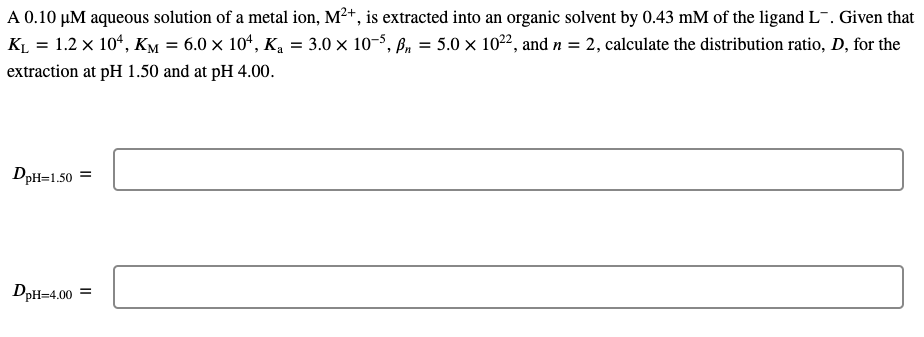A 0.10 µM aqueous solution of a metal ion, M2+, is extracted into an organic solvent by 0.43 mM of the ligand L¯. Given that KL = 1.2 x 104, KM = 6.0 × 10*, Ka = 3.0 x 10-5, Bn = 5.0 x 1022, and n = 2, calculate the distribution ratio, D, for the extraction at pH 1.50 and at pH 4.00. DpH=1.50 = DpH=4.00 =
A 0.10 µM aqueous solution of a metal ion, M2+, is extracted into an organic solvent by 0.43 mM of the ligand L¯. Given that KL = 1.2 x 104, KM = 6.0 × 10*, Ka = 3.0 x 10-5, Bn = 5.0 x 1022, and n = 2, calculate the distribution ratio, D, for the extraction at pH 1.50 and at pH 4.00. DpH=1.50 = DpH=4.00 =
Principles of Instrumental Analysis
7th Edition
ISBN:9781305577213
Author:Douglas A. Skoog, F. James Holler, Stanley R. Crouch
Publisher:Douglas A. Skoog, F. James Holler, Stanley R. Crouch
Chapter14: Applications Of Ultraviolet-visible Molecular Absorption Spectrometry
Section: Chapter Questions
Problem 14.22QAP: Mixing the chelating reagent B with Ni(II) forms the highly colored NiB22+, whose solutions obey...
Related questions
Question

Transcribed Image Text:A 0.10 µM aqueous solution of a metal ion, M²+, is extracted into an organic solvent by 0.43 mM of the ligand L¯. Given that
KĻ = 1.2 × 10ª, KM = 6.0 × 10*, Ka = 3.0 × 10-5, B, = 5.0 × 1022, and n = 2, calculate the distribution ratio, D, for the
extraction at pH 1.50 and at pH 4.00.
DpH=1.50 =
DpH=4.00 =

Transcribed Image Text:Calculate the fraction of M2+ that remains in the aqueous phase, q, if 145 mL of 0.10 µM M²+ is extracted once with 10.0 mL
of 0.43 mM L¯ at pH 1.50.
9pH=1.50 =
Expert Solution
This question has been solved!
Explore an expertly crafted, step-by-step solution for a thorough understanding of key concepts.
This is a popular solution!
Trending now
This is a popular solution!
Step by step
Solved in 3 steps with 2 images

Knowledge Booster
Learn more about
Need a deep-dive on the concept behind this application? Look no further. Learn more about this topic, chemistry and related others by exploring similar questions and additional content below.Recommended textbooks for you

Principles of Instrumental Analysis
Chemistry
ISBN:
9781305577213
Author:
Douglas A. Skoog, F. James Holler, Stanley R. Crouch
Publisher:
Cengage Learning

Principles of Instrumental Analysis
Chemistry
ISBN:
9781305577213
Author:
Douglas A. Skoog, F. James Holler, Stanley R. Crouch
Publisher:
Cengage Learning